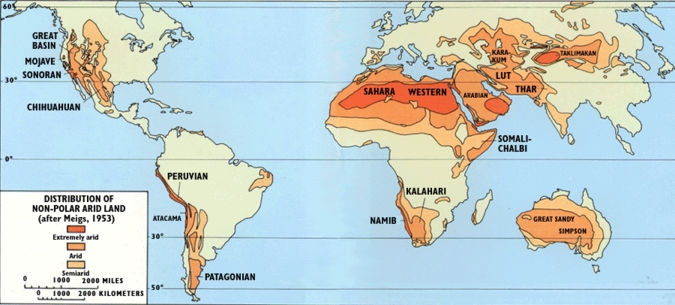
xxxxx - 21-2-2007 at 08:08
i am writing regarding world deserts. if you look at the peruvian and namibian deserts you will see they are right next to the pacific and atlantic
oceans, evaporating away in the hot sun but there is no precipition. then you go over the andes or the windhoek mountains and it rains all the time.
contrast this to seattle where there is constant rain from the pacific ocean then you go over the cascades and the cummulo-nimbus clouds containing
the rain cannot get over these mountains and then you are in the desert. this makes sense and is logical. also the interior of south america is the
rain forest with 350 days of rain each year, while the same interior area of africa is the saraha desert which is the most arid region on earth. could
someone make sense out of this?
Edit: somewhat-too-large image replaced by Polverone
[Edited on 2-22-2007 by Polverone]

solo - 21-2-2007 at 08:29
This is no answer but an explanation to the phenomena ocurring in the wetest and dryest places on the earth right next to each other.....solo
http://www.extremescience.com/DriestPlace.htm

Sauron - 21-2-2007 at 08:30
Your map is TOO WIDE for the page and is distorting the forum, please edit it down, or vulture is likely to swoop down and make it go away entirely.
Levi - 21-2-2007 at 08:31
It seems that land use and oceans are less important than the Earth's rotation when it comes to desertification. I found an article that seems to
believe so, anyhow.
http://www.climateark.org/articles/1999/sahturnd.htm
How a change in the rotation affects Africa is beyond me...
Good question.
12AX7 - 22-2-2007 at 15:15
As I recall, it has to do with the predominant wind patterns -- rising or falling -- corresponding to the three primary bands of convection current
through the atmosphere.
Where air is rising, it is losing pressure and cooling and forming clouds and thus rain. Where it is falling, it is gaining pressure and warming and
relative humidity is dropping. (Also, it's probably already given up its moisture from the rising end, so is already kind of dry to start with.)
This makes two distinct bands of arid weather, adjecent to the tropics.
Clouds tend not to flow over very high mountains. This causes a buildup of moisture on one side (as the U.S. and Canadian pacific N.W.) and dryness
on the other, likewise making some very wet conditions (as the extremescience page says).
Tim

